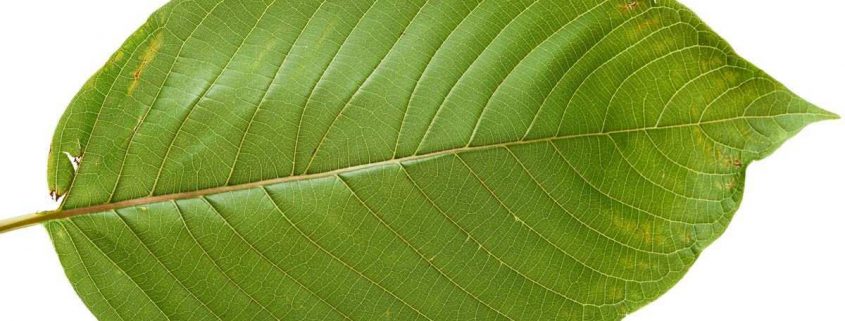Kratom is a plant species belonging to the family Rubiaceae, in the same species as coffee. The plant was described in 1839 by the Dutch botanist Pieter Willem Korthals and the British naturalist George Darby Haviland. Kratoms primary distribution is in Southeast Asia in Indochina, Malaysia, Vietnam, the Philippines, Indonesia, Thailand and New Guinea.
Kratom is a tree with leaves which are considered by locals as medicinal. The leaves are used for their psychoactive properties, above all in its range, but the practice has also spread to other parts of the world. Workers in the fields of Southeast Asia chew the leaves, often continuously throughout the day for the numbing and stimulating effect. The leaves are also cooked to produce tea. The tea can then get evaporate until there remains a kind of concentrated tar that is swallowed.
It is rare that kratom is smoked, it is considered to give bad effect and be unhealthy. Drugs based on kratom, usually with the addition of O – desmetyltramadol, is sold under the name krypton, and 2010 has been recognised to have caused several deaths. Kratom contains many active substances, including Mitragynine (previously considered to be the primary active agent), mitrafyllin and 7-hydroxymitragynin (which is now considered to be the main active substance in the plant).
Kratom has great potential as a medicinal plant, such as painkillers comparable with codeine, propoxyphene or as an alternative to methadone. It can also be used as raw material for the manufacture of other consumable chemicals.
Kratom has the potential ability to facilitate withdrawal from alcohol and opiates, as a mixture of alkaloids contained in it is an agonist in respect of receptors. According to some reports, several times higher than that of morphine. In many countries, people living with cancer, rather than prescribed painkillers opt to take unregulated extracts of kratom. Strong kratom tea (more than 10 grams of dried leaves per serving) has a pronounced analgesic and sedative effect, exceeding the required dosages are possible blurry vision, nausea, vomiting possible. Rather weak broth (approximately 3.1 grams) has stimulating properties resembling caffeine, without the side effects (such as palpitations) Relieves pain light helps to focus on any kind of activity, increases physical endurance. The duration of analgesic action of approximately 4-5 hours, incentive – 2-5 hours.
Description
They are trees that usually grow to a height of 3.7m to 9.1 m in height and 4.6 m in width, although some species can reach 12-30 m in height. Mitragyna speciosa can be perennial or deciduous, depending on the climate and the environment in which it is grown. The stem is erect and branched. The leaves of the tree are a dark green color and can grow up to over 180 mm long and 100 mm wide, are ovate-acuminate in shape, and are opposite in growth pattern. The flowers are yellow and round and tend to grow in clusters at the end of the branches. The leaves of M. speciosa are elliptic and are smaller at the end of the ramitasa. The leaves are heart-shaped at the base with petioles of 2 to 4 centimetres in length. The flowers are stacked in a terminal inflorescence that are between three and five centimetres long. The chalice is short and cup-shaped, with round lobes. The tube of the corolla is five millimetres long with three lobes.
Properties
Mitragyna speciosa behaves as an opioid receptor agonist as morphine 8 and is used in the treatment of chronic pain and also used recreationally. Its use is not detected by typical drug screening tests, but its metabolites can be detected by more specialised tests. 9 October Pharmacological effects in humans, including their efficacy and safety, are not well studied.
Most side effects are believed to be mild, although serious isolated side effects such as psychosis, seizures, hallucinations, and confusion have been reported rarely. A case has been reported in which the chronic use of Kratom was associated with bowel obstruction as well as anecdotal reports indicating that the plant carries the potential for addiction and can lead to withdrawal symptoms. There have been reports of cases in which the deaths of people who have combined kratom with other drugs or substances, but the plant itself has not been identified as a cause of death in any of these cases.
Addiction
Those who use it can constantly experience withdrawal syndromes when they stop. Some daily consumers report the appearance of minor inconveniences, comparable to those induced by coffee deprivation: nervousness, agitation, or lack of energy. Researchers in ethnology after a survey of longtime kratom users in Southeast Asia, reported that belief that users would present on the skin of their cheeks dark spots of discoloration. It does not seem, however, that the fact was actually found. No long-term human studies have been done on Kratom however being a psychoactive substance


